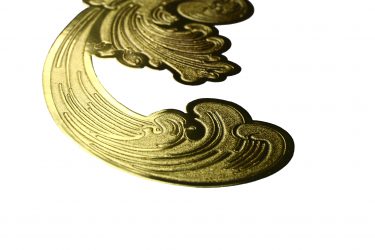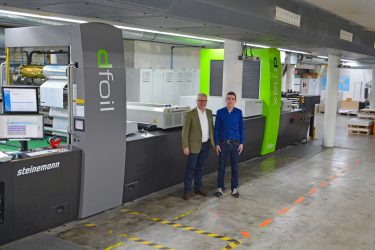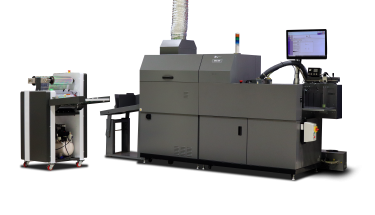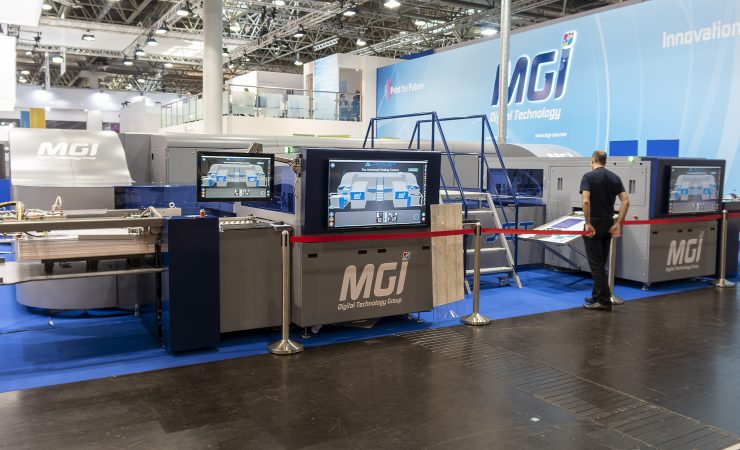Embellishment adds an eye-catching boost to ordinary colour print and is one of print’s best weapons against digital media. Simon Eccles looks at the options, both in-press and via standalone units
Giving an impression of higher quality via the group of special effects that are now referred to as embellishment should bring added value for the printer too, in terms of the margin the work can command. That’s just as well, as some of the emerging breed of digital ‘embellishment presses’ can cost more than a complete colour press.

Embellishment presses from Scodix can combine effects such as raised spot UV with foiling
Broadly they offer spot varnish (with a choice of high gloss, silk or matt), sometimes with a raised effect, and sometimes with the ability to apply a foil, whether metallic, holographic, diffraction or just a special colour.
Here we’re providing a quick run through and update of the main digital embellishment systems. Some are built into digital presses and by definition work with digital print. The standalone systems may be equally relevant to short run litho, where their lack of requirement for physical dies or plates can pay off in time and cost.
However, standalone embellishment printers can be pretty big investments – being essentially single-colour inkjet presses, they can cost more than a full-colour dry toner press. An important thing to check is whether they work straight onto paper, as some of them require a laminate to be applied first, adding to time and cost.
Hot foil gives attractive effects that can’t be achieved by ink or toner. Digital foilers don’t need metal dies and every image can be different, which suits short runs and variable data products such as business cards. However, look out for the edges of the foil, which may be more ragged than you’d get from a physical die or punch.
Most UV spot varnishers offer foiling of either the hot or cold type, with separate inline foiling units. A much lower investment will get you a hot foiler that works directly onto dry toner or Indigo prints without metal dies – by heating the print, the toner warms up more than the paper and so activates the foil’s adhesive layer. The original type, sold mainly by Caslon in the UK, have been around for decades, while more recent players include Vivid, with its Matrix range. The past five years or so have also seen thermal laminators being modified to apply hot foil onto toner in a very versatile package for minimal extra cost. We’ve covered such lamination-foiling systems often in Digital Printer, most recently in the Big Finishing Focus in the November 2019 issue.
Digital UV spot varnishers
At the end of 2019 Duplo ran a ‘soft launch’ of an add-on foiling module called DigiFoil for its DuSense Pro Sensory Coater, and this is rolling out around now, with the first installation at Flexpress in Leicester.
The DuSense inkjet ‘high build’ (raised image) spot UV printer was announced at drupa 2016 and shipped a few months later. It offers auto feeding of SRA3/B3+ sheets up to 364mm wide and 740mm long, at speeds of 1080sph. The varnish height can be varied between 20 and 80 microns to give raised and textured effects. Registration and correction to fit the printed image is performed by built-in cameras.

Steinemann offers high productivity B1 digital spot UV and foiling systems that use Kurz’s DFoil technology
The original DuSense is still available, but Duplo’s marketing manager Zunaid Rahman says that most customers are opting for the slightly more expensive Pro model, which adds a corona conditioning system that allows the varnish to adhere to untreated papers without the need for laminating. It also has a barcode reader, allowing automatic job image call-up and machine set-up as soon as a pre-printed sheet is fed. The Duplo DigiFoil hot module sits inline with the DuSense or Pro, and can be retrofitted to existing installations.
The DuSense system goes head-to-head on format with the SRA3 MGI JetVarnish 3D One, introduced last October and sold exclusively by its partner Konica Minolta. The format complements KM’s own dry toner press range, though it will work with print from any source. This is now the entry level to the MGI range, running at 2077sph with a variable varnish height from 21 to 116 microns.
So far KM hasn’t announced a foiling option, but there’s already an iFoil unit of the correct width available inline with the MGI Meteor 8700XL+ digital colour dry toner press, as a package called Meteor Unlimited Colors XL.
At the beginning of 2019 Friedheim took over the UK distributorship for the Scodix range of inkjet ‘Digital Enhancement Presses.’ At the same time Scodix announced two B2 models that fit below the very high end, very fast B1 Ultra 106. The Ultra 202 is based on the previous Ultra 2 and is described as a ‘fully featured’ model, meaning it works with any digital print (dry toner, HP Indigo, inkjet, litho) and can produce Scodix’s full range of built-in embellishment effects: Sense (raised and/or textured, Braille); Foil (hot or cold, up to four rolls); variable data; Metallic (varnish over metallised substrate); spot low build; Cast & Cure (embossed ‘holographic’ effects); Crystal (faceted gem effects); and Glitter (adds reflective glitter).
The Ultra 101 is a new entry level model, intended as an entry level to the Scodix range, intended to run with HP Indigo or litho output. It offers six built-in effects compared to the nine of the 202 and its maximum build height is 90 microns compared to the 202’s 260 microns.
Friedheim is UK distributor for the Czech Komfi range, but mainly sells its laminators rather than its Spotmatic inkjet spot varnishers, which aren’t as fully featured as Scodix.
MGI offers both sheet and roll fed models. The sheet fed JetVarnish Evolution takes B1+ format sheets at 2291sph. For B2 sheets running in portrait format then it’s 3123sph, and you’d also run some of the long B3 format sheets this way (with throughput depending on the actual sheet length). The 75cm kit lets it take B2 in landscape orientation across the width, boosting throughput to 4200sph. The top-of-the-range JetVarnish 3D Evo 75 – with the iFoil module – has recently seen its first UK installation at South Yorkshire trade printer Route 1 Print.
A year ago the German metallic foil manufacturer Kurz demonstrated its new DM-Jetliner inkjet web digital foiler at an HP customer event, running inline with an HP Indigo 6900 web-fed label press. This applies Kurz’s own Digital Metal foil and can be fitted before or after the press.
Steinemann, a Swiss company, has developed a foiling module called DFoil to fit inline with its DMax spot UV varnisher, available in 72 and 106cm widths. It applies Kurz Digital Metal foils over the spot UV (which can be flat or raised), from up to seven separate rolls. Its speed is up to 5000 B1sph or double that for B2. Heidelberg is Steinemann’s UK agent for these systems.
UK manufacturer Autobond also can add cold foiling to its SUV spot UV units that it originally developed to run inline with its heavy duty laminators for 360, 520 and 740mm sheets. These can apply up to 100 micron thickness. It can also offer hot foiling for toner-based print.
For smaller formats, UK supplier i-Sub Digital offers a cold foiling option called Digi-Foil for the Mimaki UJF range of small UV-LED flatbeds, based on a modified Vivid Matrix laminator and foil feeder that works with Mimaki’s sticky primer ink. A hand foil feeder can be used with larger format sheets from the JFX200 flatbed, which prints the same primer.
On-press effects
Kodak was the first company to offer on-press embellishment with its first five-unit Nexpress models in 2002. Today it still has the widest choice of special toners on Nexpresses and the later Nexfinity models, though it hasn’t added many in recent years. Kodak’s Dimensional clear toner can produce variable height images up to 40 microns after heat treatment. There’s an alternative 2D clear toner too, with various software options to produce protective coatings over image areas and an external finisher to polish it to high gloss. The only true metallic is gold, not silver. Instead a ‘pearlised’ sort-of-metallic effect can be created over grey tints (or other colours) with clear toner. There’s an opaque white which works over metallised or self-coloured media.

Duplo’s DuSense Pro with the Digit Foil option allows both spot UV and foiling to be combined
Ricoh and Xerox have introduced embellishment toners for fifth units on some dry toner presses: Xerox’s latest Iridesse has six units and can print for instance gold plus silver, or white then colours then a metallic. HP Indigo offers opaque white, silver and spot clear gloss on its SRA3, B2 and roll-fed liquid toner models. It’s possible to build up raised clear effects with multiple passes, but each extra layer adds a click charge. MGI’s Meteor presses are four-colour only, but the optional Unlimited Colors XL version uses inline hot foiling to add extra colours and effects.
The various inkjet presses shipping so far do not offer inline embellishment. However MGI’s forthcoming AlphaJet B1 print system, due to be launched at drupa, will combine four or six colour Memjet aqueous inkjet printing with UV white, UV 3D JetVarnish and iFoil units to produce single-pass embellished print.
Note that the use of a truly opaque white ink/toner over a metallised paper or board can give a very realistic foil effect where ‘holes’ in the coverage let the metallic base show through. The cover of Digital Printer’s December 2019/January 2020 issue was done this way by Duplo, using a Ricoh press to put white over mirror-finish silver paper, then lay colour over that (including over the silver to get other metallics) and then used its DuSense Pro spot UV printer to give it an embossed feel. If you have the issue, you can judge the results for yourself.





